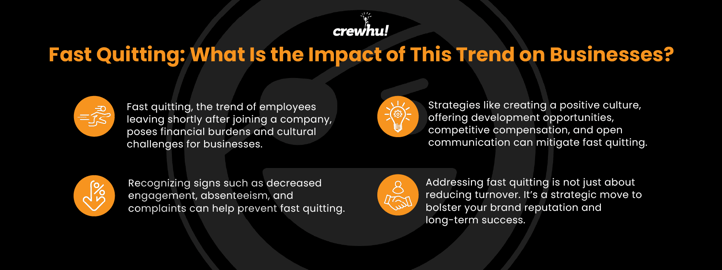Fast Quitting: What Is the Impact of This Trend on Businesses?

Combatting fast quitting is not just about retaining talent; it’s about securing your organization’s future success.

Welcome to an eye-opening journey into the world of “fast quitting” – a trend that’s reshaping the workplace landscape. In this article, we’ll dive deep into this concerning phenomenon and its impact on businesses.
What is fast quitting?
Fast quitting, also known as quick quitting, is a growing challenge in today’s workplace. It refers to the tendency of employees to leave a job shortly after joining a company, often within the first few months. This phenomenon can have significant consequences for businesses, making it essential for CEOs and managers to understand and address it proactively. Here’s how it impacts various aspects of an organization:
Costs associated with high employee turnover
One of the most immediate and tangible effects of fast quitting is the financial burden it places on organizations. Constantly recruiting, onboarding, and training new employees can be expensive and time-consuming, affecting the bottom line.
Impacts on company culture and morale
High turnover rates can erode company culture and morale. Employees may become demotivated or disengaged when they witness colleagues constantly leaving, leading to a negative work environment. Poor morale and unmotivated employees can have a significant effect on a company’s bottom line, as studies show that businesses with engaged employees outperform their disengaged peers by 147% in earnings.
Risks to productivity and performance
Fast quitting disrupts workflow and creates gaps in team dynamics. This can lead to decreased productivity and performance levels, which can have far-reaching consequences for an organization’s success.
Implications for recruiting and talent management
High turnover can also damage a company’s reputation in the job market. It becomes more challenging to attract top talent, as potential candidates may be hesitant to join a company with a reputation for quick turnover.
As you can see, fast quitting has significant and detrimental effects on business, which is why leaders and managers need to recognize the signs and put a stop to it before it starts.
Signs that employees are considering fast quitting
Recognizing the signs that employees might be considering fast quitting is crucial for turning this trend off before it becomes a problem. Here are key indicators to watch for:
Decreased engagement and motivation
Employees who are contemplating fast quitting often exhibit decreased engagement and motivation. They may seem disinterested in their work or disengaged from team activities.
Absenteeism or tardiness
Absenteeism or tardiness can be a red flag. Employees who are thinking about leaving might start showing up late or taking more unscheduled absences.
Lack of interest in career development opportunities
When employees are not interested in their professional growth within the company, they are likely thinking about moving on. Identifying and addressing this lack of interest is crucial.
Negative feedback or complaints
Pay attention to negative feedback and complaints from employees. Often, they signal underlying issues that, if left unaddressed, can lead to fast quitting.
Of course, recognizing the warning signs is just the first step toward solving the problem.
Strategies for preventing fast quitting
To mitigate the trend of fast quitting, businesses can implement several proactive strategies. These include:
Creating a positive company culture and values
Fostering a positive company culture that aligns with core values is essential. Employees who feel valued and connected to the company’s mission are less likely to leave.
Providing opportunities for professional development and growth
Continuing training, mentorship programs, and opportunities for career advancement can keep employees engaged and invested in their future with the organization.
Offering competitive compensation and benefits
Ensure your compensation and benefits packages are competitive within your industry. Discrepancies in pay can drive employees to your competitors.
Encouraging open communication and feedback
Establish a culture of open communication where employees feel comfortable sharing their concerns and ideas. This can help address issues before they escalate and lead to fast quitting.
Essentially, you want to create an environment that makes people want to come to work, where employees feel like their efforts are appreciated and rewarded. Satisfied, engaged employees won’t be looking for opportunities elsewhere.
Conclusion
Fast quitting significantly impacts businesses, jeopardizing their financial stability, culture, and talent acquisition. But there are simple steps you can take now to ensure that this concerning trend doesn’t take root in your organization.
Employee recognition and gamification platforms like Crewhu can go a long way toward creating the kind of company culture that values employee contributions and keeps them engaged. Our expert consultants can guide you in retaining top talent, fostering a positive environment, and building a successful workplace. Start your journey toward employee retention and organizational success with us today!
Topics: Company Culture, crewhu, fast quitting, short-term working, employee turnover, workplace challenges, retention strategies







